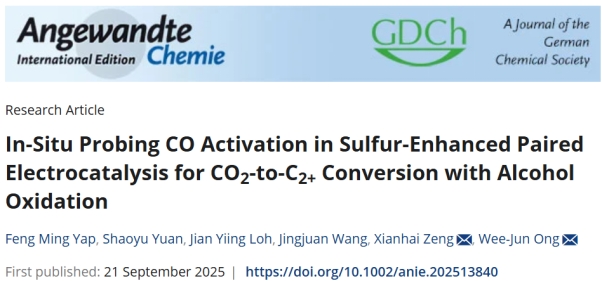XMUM and XMU Co-Publish in Angewandte Chemie International Edition
2025-10-17In September 2025, Prof. Zeng Xianhai from Xiamen University and Prof. Ong Wee-Jun from Xiamen University Malaysia published a research article titled "In-Situ Probing of CO Activation in Sulfur-Enhanced Paired Electrocatalysis for CO2-to-C2+ Conversion with Alcohol Oxidation" in Angewandte Chemie International Edition, with Yap Feng Ming and Yuan Shaoyu as are co-first authors.

The study presents an integrated strategy that enables simultaneous electrochemical carbon dioxide reduction (CO2RR) and alcohol oxidation (AOR) for the selective synthesis of high-value chemicals. At the core of the system is a self-supported electrocatalyst composed of sulfur-enhanced CuBi2O4 nanospheres (SCB) anchored on nitrogen-doped reduced graphene oxide nanosheets (NrGO), providing a robust structural framework and efficient charge transfer pathway.
The catalyst achieved a Faradaic efficiency for C2+ products exceeding 92.4% over 200 hours, with near-complete selectivity toward benzaldehyde and over 83% selectivity toward furfural. In-situ Raman spectroscopy combined with density functional theory (DFT) calculations revealed the *CO dimerization process and intermediate coverage, offering mechanistic insights into the catalytic pathway. When integrated into a solar-driven platform, the system reached a solar-to-fuel conversion efficiency of 16% while maintaining over 98% performance stability.
Yap Feng Ming, co-first author, introduced that the project began with the aim of directly observing reaction intermediates during CO2 reduction. The team at XMUM developed a sulfur-enhanced CuBi2O4 nanosphere catalyst on nitrogen-doped graphene, achieving 16% solar-to-fuel conversion efficiency when integrated into a solar-powered system. Collaboration with Prof. Zeng Xianhai's team at XMU allowed the reaction mechanism to be explored at the atomic level using DFT studies, while EXAFS and XANES analyses at XMU's College of Chemistry and Chemical Engineering further revealed details of the catalyst's electronic structure.
"This study marks the first collaboration between Xiamen University Malaysia (XMUM) and Xiamen University (XMU) China, and I'm deeply proud of what we've achieved together." commented Yap Feng Ming, "Publishing this work in Angewandte Chemie International Edition is both a personal milestone and a step forward for future collaborations bridging Malaysia and China in sustainable energy research."
Prof. Dr. Ong Wee Jun | Dr. Ong Wee Jun is a Professor and the Assistant Dean at School of Energy and Chemical Engineering, Xiamen University Malaysia. In 2021, he became the Director of Center of Excellence for NaNo Energy & Catalysis Technology (CONNECT). His research interests include nanomaterials for photo(electro)catalytic and electrochemical H2O splitting, CO2 reduction, H2O2 synthesis, N2 fixation, alcohol oxidation and organic synthesis as well as microwave plasma methane cracking for graphene and hydrogen production. He has received many prestigious awards, including 2019-2024 Global Highly Cited Researcher (Clarivate Analytics), 2020-2024 World's Top 2% Scientists by Stanford University, 2024 Malaysia Scopus Research Excellence Award and many more. For more details, refer to his website: https://sites.google.com/site/wjongresearch/ |







